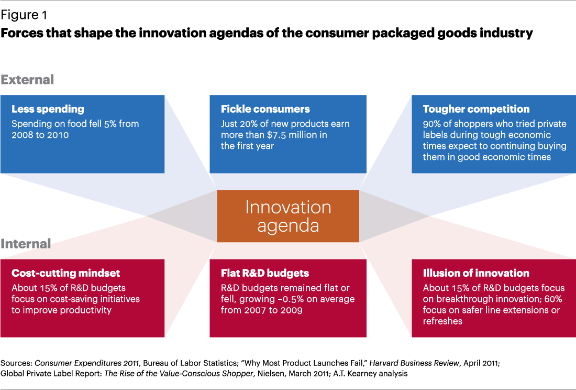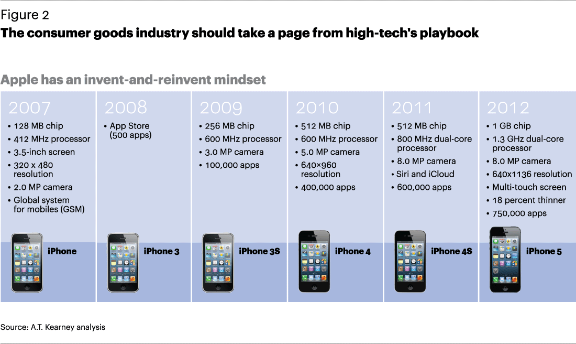
The secret to being the sharpest pencil in the innovation drawer is an R&D organization that thinks fast and plans ahead—from start to finish.
"I will build a car for the great multitude. It will be large enough for the family, but small enough for the individual to run and care for." - Henry Ford
“People are inherently creative. They will use tools in ways the tool-makers never thought possible." - Steve Jobs
"There was much, much more business out there in small-town America than anybody, including me, had ever dreamed of." - Sam Walton
Ford, Apple, and Wal-Mart were all driven by charismatic leaders whose insights defined innovation in the 20th century.
These visionaries understood that the future must be different from the past.
When companies are young, visionary thinking is easy to instill in marketing, operations, and R&D.
But as they mature, this zeal often gives way to the mundane and managing the day-to-day business.
Today, consumer packaged goods (CPG) companies in particular are faced with tough competition, flat R&D budgets, private labels that can easily and cheaply clone products, and fickle consumers who crave the latest and greatest products.
No wonder these companies are battling the "illusion of innovation" and looking to, well, reinvent innovation.
In this challenging market, how do leading companies stay on top?
We recently profiled 10 of the world's largest CPG companies to evaluate their innovation mettle and determine how their R&D organizations have adapted to today's market pressures. Our goal was simple: find out how leaders are reinventing innovation.
And our focus was not on one-hit wonders but on companies that are likely to sustain innovation over time.
Sustainable Innovators
What makes some CPGs better than others at maintaining innovation over time?
Our findings suggest that these companies, we call them "sustainable innovators," apply foresight to the R&D function and avoid the pitfalls that take down even the most potent competitors.
Essentially, they think of innovation as an end-to-end value chain that is focused on the future - from idea management, product development, and launch to managing the entire life cycle of every product.
Sustainable innovators share three important characteristics:
Pursuit of breakthrough, consumer-driven innovation
Innovation projects generally fall into five categories:
- Breakthrough,
- Line extensions,
- Refresh,
- Productivity,
- and Other.
For sustainable innovators, a substantial boost in sales does not come from simply refreshing existing products or line extensions. It comes from breakthrough innovations that tap into unmet consumer needs.
Successful innovation decisions are driven by consumer needs and lead to either new products or significantly expanded product categories.
Yet few firms are set up for breakthrough innovations.
Leading companies invest roughly 15 percent on breakthrough projects and an estimated 60 percent on line extensions or refreshing current products.
One reason is that launching new products is risky.
Only 20 percent of new products achieve more than $7.5 million in year-one sales, and less than 3 percent achieve more than $50 million in sales the first year (see figure 1).
Another reason is that getting to a breakthrough innovation can require multi-year commitments.
But with few incentives to pursue these, and most financial targets designed to be met within one year, it is difficult to defend investments in breakthrough innovation and a multi-year development cycle.
Line extensions, by comparison, are usually completed within a fiscal year.

Adding to the dilemma, brand managers are offered incentives for new product launches (even if the launch cannibalizes existing sales) rather than for projects with long-term growth potential.
And what about those popular functional stage-gate processes set up to fund, monitor, and assess R&D initiatives?
Our executives admit to favoring quick wins over big bets and are often swift to pull the plug on inherently risky breakthrough ideas.
Identifying and championing breakthrough innovation worthy of development requires an R&D function that is fluent in consumer knowledge—understanding not only customers' lingo but also their needs.
This is a skill not typically associated with scientists huddled over laboratory glassware, so more CPG companies are beginning to form dedicated innovation teams in which people from marketing, sales, operations, procurement, and R&D come together to determine what is truly innovative and to beat the bushes for new ideas.
As we gain a better understanding of successful innovation—the kind primarily driven by consumers' needs—the next generation of R&D professionals will likely need different skills; they will have to be technically adept, creative problem solvers, and excellent cross-functional facilitators.
The best of the best will be well-versed in the language of marketers and able to fully exploit a consumer-driven mindset.
An invent-and-reinvent mindset
Numerous changes can take place in a product life cycle.
The underlying cost structure can change because of volatility or commodity shortages that force down margins.
Competitors may release an improved version of a top product.
A private label may replicate a top-selling product and gain market share simply by being cheaper.
Few companies are prepared for these changes, however, primarily because they have failed to review the product in terms of its performance.
Reviews are vital, used to monitor the success of a product through its life cycle and, as in the high-tech industry, to continually reinvent even best-selling products to insulate them from ruthless competitors and private label upstarts.
Apple is an ideal example of a company that has weathered its share of ups and downs (see figure 2).

For decades now, functions such as supply chain and procurement have used those well-worn scorecards to identify strengths and opportunities to drive continuous improvement.
Now it is R&D's turn to become accountable for constant reinvention.
Monitoring can identify a product with declining market share and trigger a deeper look at the product's attributes in light of evolving consumer preferences, which in turn can help rebuild market share and increase profitability over the life cycle of every product.
Link productivity to innovation
Most of the companies in our study allocate about 15 percent of their R&D budgets to improving productivity.
And they use a host of initiatives to do so, from portfolio simplification, "lift and shift" across global platforms, and cost-efficient design and packaging, to streamlining the product life cycle.
Each one does a good job of cutting costs and can have a positive impact across products, divisions, and functions.
Yet none of these initiatives insulates companies or their products from ruthless private-label competitors, commodity price fluctuations, supply source issues, or sudden shifts in consumer preferences.
Today's volatile world requires more innovative thinking to protect and grow market share. Rather than yesterday's tried and comfortable approaches, we suggest a "no sacred costs" approach to product evaluation to reveal changing consumer preferences, new supply sources, and formulations that can improve margin performance.
Also, as the role of R&D is now inextricably linked to productivity, there is an opportunity to link productivity to innovation and, importantly, for R&D to measure its own performance. Rather than constantly struggling to justify budgets, R&D builds a record of performance in its contributions to innovation and to productivity much the same way as operations and procurement measure their impact on productivity.
Securing Advantage
CPG companies seeking to reinvent innovation also need an R&D organization that is driven by unmet consumer needs, is continually monitoring product performance with an invent-and-reinvent mindset, and links productivity to innovation.
Innovators also have a market research budget that is focused on transaction data and analysis on one hand and trend research on the other.
Knowing what consumers want today will deliver an immediate impact; anticipating what they will want tomorrow will secure long-term growth and competitive advantage.
December 2012
A.T. Kearney
[ add comment ] ( 69 views ) | permalink |




 ( 3.1 / 773 )
( 3.1 / 773 )

 Calendar
Calendar